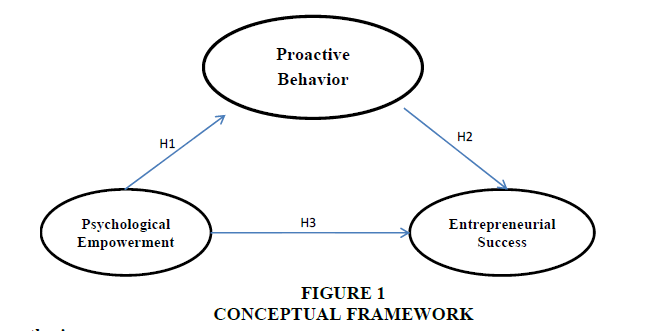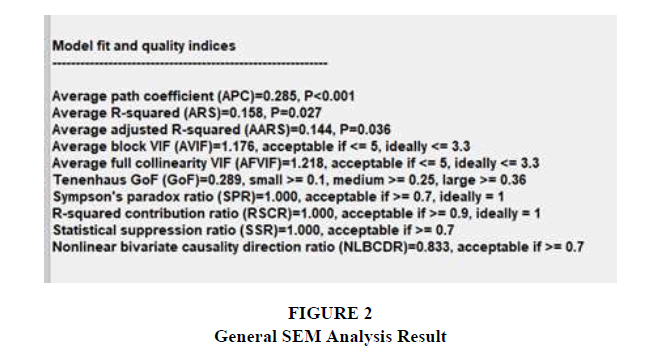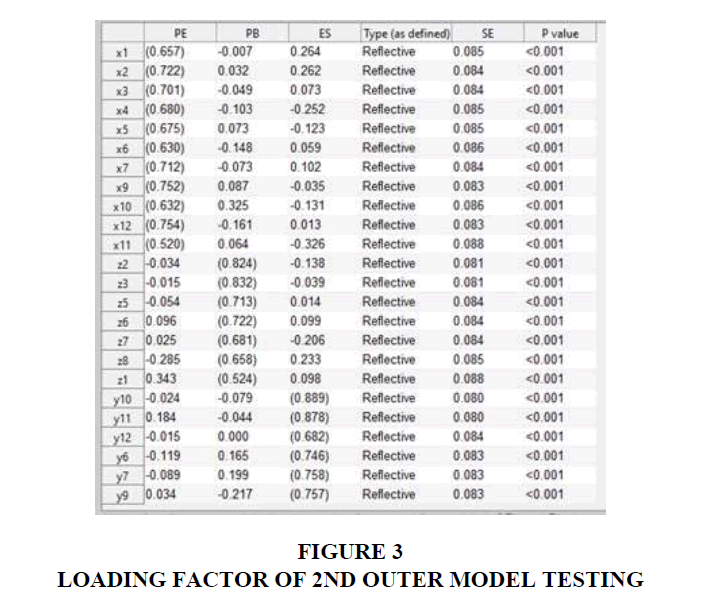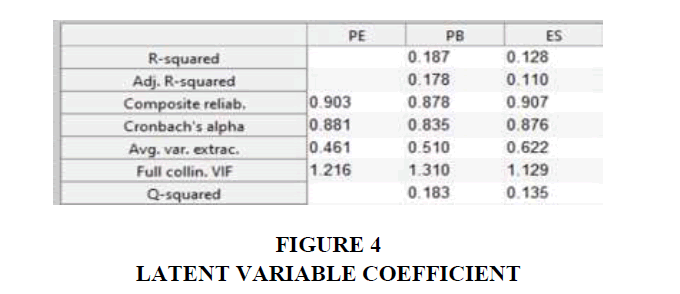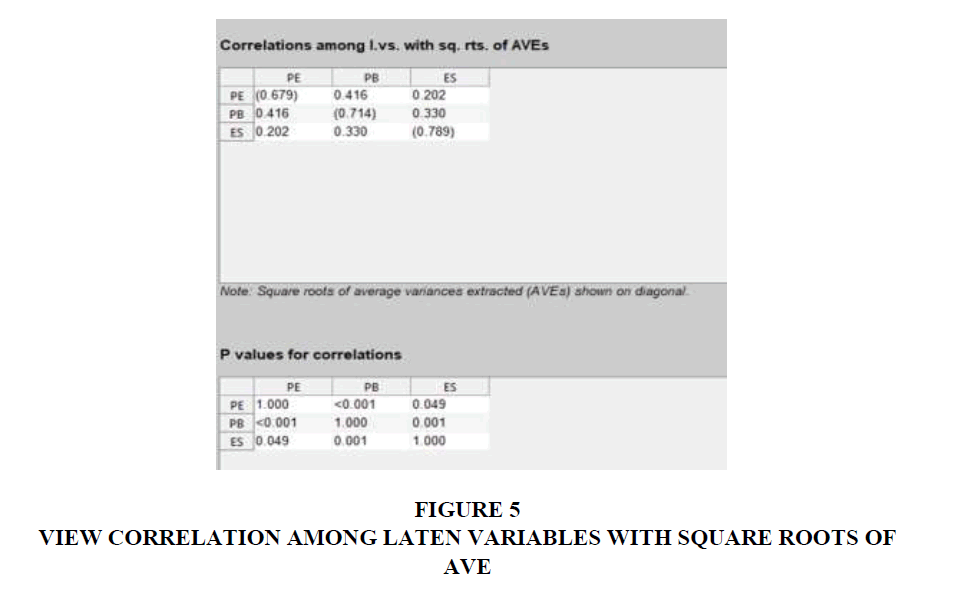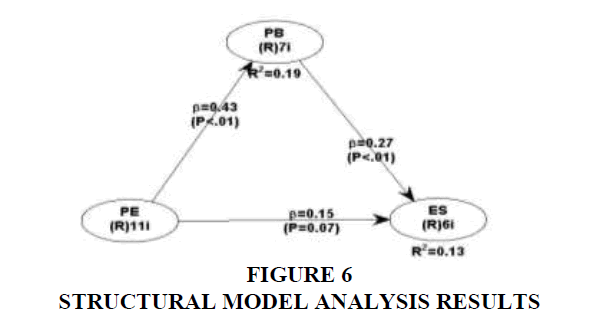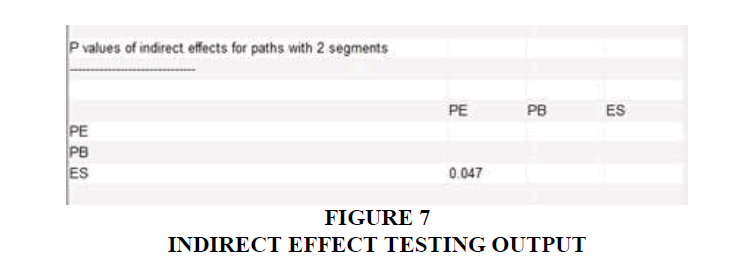Research Article: 2021 Vol: 27 Issue: 4S
Psychological Empowerment and Women Entrepreneurial Success the Mediating Role of Proactive Behavior
Eviatiwi Kusumaningtyas Sugiyanto, Universitas Diponegoro
Mirwan Surya Perdhana, Universitas Diponegoro
Shintya Novita Rahmawati, Universitas Diponegoro
Abstract
The aims of Women Empowerment of in economic is to increase the contribution of women in economic, such as entrepreneurship, but despite the increasing number of businesses owned by women, such businesses are less successful than those owned by men according to economic measures of business success. In addition, the result of previous study is vary, especially in psychological empowerment on performance which is also become a separate problem in this study. This study aims to close the research gap on the effect of psychological empowerment on business success by including proactive behavior as an intervening variable. Questionnaire on 96 women entrepreneurs in Semarang were used as data collection. The analysis technique used is Structural Equation Modeling with the WrapPLS 7.0 program. The results shows that proactive behavior is able to close the research gap and become a mediator variable (full mediation) to influence psychological empowerment and entrepreneurial success.
Keywords
Entrepreneurial Success, Psychological Empowerment, Proactive Behavior
Introduction
The development of entrepreneurship, especially women entrepreneurs in developing countries such as Indonesia, has become a driving force for women's empowerment and social transformation. Currently, a lot of women entrepreneurs are involved in micro, small and medium enterprises. Bank Indonesia said that women entrepreneurs in Indonesia managed to contribute 9.1% of the national Gross Domestic Product (GDP) in 2017.Data from Indonesian Ministry of Laboursees a positive trend, where the number of Indonesian women entrepreneurs continues to increase every year, reaching 14.3 million in 2018 (Trihendrawan, 2019). Women entrepreneurs are increasingly becoming important contributors to the level of entrepreneurial activity and economic growth in their countries (Brush, 2006; Powell & Eddleston, 2013).
Despite the increasing number of businesses owned by women, such businesses are less successful than those owned by men according to economic measures of business success (Brush, 2006; Powell & Eddleston, 2013); businesses owned by women tend to have slower growth and sales, performance, and lower profits than male-owned businesses.This may be because women entrepreneurs have less access to the resources (eg, human, social, financial capital) that would support their business ventures than male entrepreneurs (Brush, 2006; Powell & Eddleston, 2013). If women entrepreneurs initially started out with fewer business with relevant resources than male entrepreneurs, the additional resources from their family domain might be more meaningful to their business success (Powell & Eddleston, 2013).
This description indicates the existence of a gap phenomenon, namely the increasing number of women entrepreneurs in one and on the other hand, the success of women's businesses tends to be lower than that of men's. The issues of women's entrepreneurship cannot be separated from the topic of empowerment. Psychologically empowered women are more likely to have success than psychologically powerless women. Psychological empowerment has a role as a process that allows a person to increase persistence and engagement on tasks that will lead to successful performance (Wallace et al., 2011). Psychological empowerment can be an internal motivation in individuals. With psychological empowerment, a person will feel meaningful, skillful, be able to make their own decisions and have an impact on others, they believe in their ability to complete work without doubts, so their performance may increase (Chiang & Hsieh, 2012).
Several previous studies have examined the impact of psychological empowerment on business performance or success. However, some of these studies show different results. Studies results can be seen in Table 1 of the research gap.
| Table 1 Research Gap On Psychological Empowerment To Business Perfomance/Success |
|
| Researcher | Result |
|---|---|
| Mahama and Cheng (2013), (Dewettinck, 2003); Ölçer (2015) | Psychological Empowerment has no effect on performance or partially supported |
| Chiang and Hsieh (2012), (Degago, 2014); Tuuli (2009); (Wallace et al., 2011) | Psychological Empowerment has an effect on performance |
The differences in the results of previous studies can be caused by the existence of other variables that interact with the relationship between the two previous variables, either as an intervening variable or as a moderating variable. This study tries to close the research gap by using proactive behavior variables. The basis for using these variables to close the gap in the effect of psychological empowerment on entrepreneurial success is that the productive potential of an individual can come out through empowerment. Empowerment links proactive behavior to their competences and strengths. Empowered individuals will actively carry out their duties, channel their energy and enthusiasm without thinking about rewards (Henao-Zapata & Peiró, 2018). In addition, individual proactive behavior results in beneficial things such as higher levels of innovation, leadership effectiveness, task performance and greater career success, all of which contribute positively to organizational performance and development (Batisti? et al., 2016). So that through individual behavior a person can achieve business success.
The gap phenomenon states that despite the increasing number of businesses owned by women, such businesses are less successful than those owned by men according to economic measures of business success. In addition, the different results of previous study related to the effect of psychological empowerment on entrepreneurial success became a separate phenomenon in this study. Based on the description, the problem formulation in this study is how to build the success of women entrepreneurs through psychological empowerment through proactive behavior. Three hypotheseswas proposed in this study; the effect of psychological empowerment on proactive behavior & entrepreneurial success, and the effect of proactive behavior on entrepreneurial success.
Methodology
The method used is Structural Equation Modeling (SEM) with the WrapPLS 7.0 program. Through PLS, a model test will be carried out which includes the Outer Model and Inner Model. While the data collection method in this study was carried out by distributing questionnaires to 96 female entrepreneurs in the city of Semarang.
The psychological empowerment variable was measured by 12 indicators (Helmy, 2019; Spreitzer, 1995). The proactive behavior variable is measured using 8 indicators from (Huang, 2017). Meanwhile, the entrepreneurial success variable is measured using 12 indicators from (Tu, Hwang, and Wong 2014). Each indicator item was assessed using a 5 scale from 1 (strongly disagree) to 5 (strongly agree). The causal relationship between these variables with the research hypotheses is shown in Figure 1.
Results and Discussion
Model Fit Test Results
WrapPLS 7.0 uses ten measures of good of fit (GoF) to measure the overall fit of the model. These measures are APC (Average Path Coefficient), ARS (Average R Squared), Average adjusted R-squared (AARS), AVIF (Average Block Variance Inflation Factor), Average full collinearity VIF (AFVIF), TenenhausGoF (GoF), Sympson's paradox ratio (SPR), R-squared contribution ratio (RSCR), Statistical suppression ratio (SSR), and Nonlinear bivariate causality direction ratio (NLBCDR). The result of Model Fit test can be seen in Figure 2.
From the general results above, it is known that the model has a good fit. These results are indicated by 10 measures fit model compared with the rule of thumb, as in the Table 2.
| Table 2 Comparison Of Model Fit Values ??With Rule Of Thumb |
|||
| Criteria | Value | Rule of Thumb | Explanation |
|---|---|---|---|
| APC | 0.285, P=0.004 | P-Value ≤ 0.05 | Accepted |
| ARS | 0.158, P=0.027 | P-Value ≤ 0.05 | Accepted |
| AARS | 0.144, P=0.037 | P-Value ≤ 0.05 | Accepted |
| AVIF | 1.176 | ≤ 5 | Accepted |
| AFVIF | 1.218 | ≤ 5 | Accepted |
| Goodness Tenenhaus | 0.289 | ≥ 0.36 | The Power of Medium Prediction |
| SPR | 1.000 | ≥0.7 ideally 1 | Ideal |
| RSCR | 1.000 | ≥ 0.7 ideally 1 | Ideal |
| SSR | 1.000 | Harus ≥ 0.7 | Accepted |
| NLBCDR | 0.833 | Harus ≥ 0.7 | Accepted |
Measurement Model Analysis
Evaluation of the model measurement or outer model is carried out to assess the reliability and validity of the latent construct forming indicators (Ghozali, 2013). The parameters used to see the reliability are loading factor and composite reliability. Meanwhile, the parameter used to measure the validity is Average Variance Extracted (AVE). Testing the outer model is carried out twice in the first test; There are several indicators that have a loading value below 0.5 so that they are removed from the model. The loading value does not meet the criteria for indicator reliability. According to (Ghozali, 2013); (Hair, 2019)the loading factor value of 0.4 - 0.5 is considered as sufficient. So, to meet these criteria, loading values below 0.5 are removed from the model. The indicators issued from the model are an indicator for psychological empowerment (X8), one indicator for forming proactive behavior (Z4), and there are six indicators for forming entrepreneurial success (Y1, Y2, Y3, Y4, Y5 and Y8).
The results on the latent variable coefficient show that the composite reliabilityvalue for all variables is above 0.7 as well as the values of Cronbach alpha are all above 0.7 so that it meets the internal consistency reliability. It can also be seen that the AVE value is good, where the value is above 0.5 so that it meets the convergent validity, except for the psychological empowerment variable. The full collinearity VIF value for each variable is also good, namely < 3.3 so that there are no vertical or lateral collinearity problems in the model. The Q-squared resulting value for each dependent/endogenous variable is more than zero which means that the model has predictive relevance.
The Results ofView Correlation Among Laten Variables with Square Roots of AVE testingshows that three latent variables also have high discriminant validity. The diagonal line of the correlation between the above latent variables is the root of the AVE. Because the square root value of AVE is higher than the correlation between variables, it can be concluded that the latent variable has good discriminant validity.
Structural Model Analysis
The evaluation of the structural model or inner model aims to predict the relationship between latent variables by seeing how much variance can be explained and to determine the significance of P-Value (Ghozali, 2013). The evaluation results of structural model of this study can be seen in the Figure 6.
Based on figure 6, the following results are obtained 1) Psychological Empowerment (PE) has a significant positive effect on Proactive Behavior (PB), Proactive Behavior (PB) has a significant positive effect on Entrepreneurial Success (ES), 3) Psychological Empowerment (PE) has no effect Entrepreneurial Success (ES). The coefficient R-Square for Proactive Behavior (PB) is 0.19 which means that the variation of Proactive Behavior (PB) can be explained by Psychological Empowerment (PE) by 19%. Meanwhile, the coefficient R-Square for Entrepreneurial Success (ES) is 0.13 which means that Proactive Behavior (PB) and Psychological Empowerment (PE) are able to explain the variation of Entrepreneurial Success (ES) by 13%.
Indirect Effect
The indirect effect model in this study is the effect of Psychological Empowerment (PE) on Entrepreneurial Success (ES) through Proactive Behavior (PB). The result of structural model analysis shows that the effect of Psychological Empowerment (PE) on Entrepreneurial Success (ES) is not significant, while the effect of Psychological Empowerment (PE) on Proactive Behavior (PB) is significant and the effect of Proactive Behavior (PB) on Entrepreneurial Success (ES) is also significant. Furthermore, from the results of the indirect effect output for Proactive Behavior (PB) is significant at 0.047 <0.05, all of these means that Proactive Behavior (PB) can be a mediator variable (full mediation) for Psychological Empowerment (PE) and Entrepreneurial Success (ES).
Discussion
The productive potential of an individual can come out through empowerment. Psychological empowerment is a collection of cognitive experiences manifested in a sense of meaning, competence, impact and self-determination (Tuuli, 2009). Meaning refers to the concern of workers in relation to their job. Competence refers to the level of self-confidence and self-efficacy of workers. Self-determination refers to the freedom, autonomy and control of workers through their work. Impact reflects employee involvement and worker participation in the decision making process. Empowerment theory argues that someone who is empowered can get work done in a more efficient way than someone who is less empowered (Al-Bsheish et al., 2019). The four cognitions of psychological empowerment reflect an active orientation towards work roles. What is meant by active orientation is where someone wants and feels capable of shaping the role and context of work. Lack of one dimension will not eliminate feelings of empowerment but can reduce the overall level of perceived empowerment (Spreitzer, 1995). Empowerment links proactive behavior to their competencies and strengths. Empowered individuals will actively carry out their duties, channel their energy and enthusiasm without thinking about rewards (Henao-Zapata & Peiró, 2018). Empowerment facilitates proactive behavior by encouraging an implemental mindset and increasing freedom of action. Implemental mindset refers to the readiness to move forward looking for ways to act. Individuals who feel psychologically empowered are more likely to act freely and independently in situations of risk and uncertainty, anticipate problems, and show tenacity and ingenuity when conditions are challenging. The four cognitions of psychological empowerment represent an active rather than a passive orientation to work roles. What is meant by active orientation is where a person wants and feels able to shape the role and context of the work (Spreitzer, 1995).
Proactive Behavior Has a Significant Positive Effect on Entrepreneurial Success
Proactive behavior is self-initiated, focused on the future, and involves returning to control to bring about change (Cooper-Thomas et al., 2014). Proactive behavior is aimed at increasing people's compatibility with the environment in the work context. (Ashford, 1996) (Cooper- Thomas et al., 2014) Identified seven proactive behaviors including 1) seeking information, 2) seeking feedback, 3) general outreach, 4) networking, 5) building good relationships with leaders, 6) negotiating job changes, 7) investigating performance and work satisfaction. Proactive behavior was associated with positive outcomes including greater learning, social integration, role innovation, job satisfaction and lower intention to leave.At the individual level, proactive behavior is about taking the initiative to improve current circumstances by challenging the status quo rather than passively adapting to current conditions. An adequate level of proactive behavior is necessary for an organization to create its own future; through innovation in products or services, transformation of its business model or organizational change (Batisti? et al., 2016). Furthermore explain that the proactive behavior of individuals results in beneficial outcomes such as higher rates of innovation, leadership effectiveness, greater job performance and career success, all of which contribute positively to organizational performance and development. Four proactive behaviors according to (Caniëls, Neghina, Schaetsaert, Carayannis, & Grigoroudis, 2017) (Parker, 2010) are taking charge, voice, individual innovation, and problem prevention. Proactive behavior is very important because this behavior is anticipatory, change-oriented and has the initiative to be independent which is necessary for entrepreneurial success (Gielnik et al., 2015; Glaub, Frese, Fischer, & Hoppe, 2014). Proactive behaviors increase the chances of entrepreneurial success (Henao-Zapata & Peiró, 2018). The proactive behavior of individuals results in beneficial things such as a higher level of innovation, leadership effectiveness, task performance and greater career success, all of which contribute positively to organizational performance and development (Batisti? et al., 2016).
Psychological Empowerment Has No Effect on Entrepreneurial Success
The word "success" is defined as a profitable or prosperous venture. Perceptions of benefit for one individual with another individual can be different, as well as indicators of attaining prosperity can vary from various points of view. Thus, the achievement of all forms of success can be determined subjectively and objectively (Fisher et al., 2014). Entrepreneurial success is an expression of its acceptable use. The term entrepreneurial success refers to the expression of the success of a business or business activity. Entrepreneurial success can be informed as a cultural issue or depending on an individual's perspective. Several entrepreneurs were found to have different perceptions of entrepreneurial success (Fisher et al., 2014). Achievement of wealth is a typical indicator of success (Fisher et al., 2014; McMullen, 2006) however attainment of wealth is not always considered as a measure of business success (Alstete, 2008). From a gender perspective it also affects the perception of success. External standards are used by men to measure success, such as getting recognition for achievement; whereas women use internal standards of success, such as those that are achieved as they set themselves (Fisher et al., 2014). Entrepreneurial success is measured by various indicators including goal achievement, economic success, lifestyle, and company growth (Fisher et al., 2014; Rauch, 2000). Another dimension of entrepreneurial success consists of opportunity identification, refinement of business concept and resource acquisition, and survival and growth. (Dewettinck, 2003) states that a person's feelings of empowerment can only lead to certain performance outcomes if these feelings are translated into appropriate behavior. Another reason is expressed by (Dewettinck, 2003) that empowerment as an activity is not directed at certain goals such as business success, but empowerment is universal, available for all purposes, which makes the effect of empowerment on performance blurred. For example, someone who feels empowered to behave to achieve the goal of X (eg customer satisfaction), but not for the purpose of Y (eg maximizing productivity).
Conclusion
This study intends to provide empirical evidence on how to build a successful female entrepreneurial business through psychological empowerment and proactive behavior. From the result of this study, it can be concluded the results of the study can be concluded that 1) Psychological Empowerment has a significant positive effect on Proactive Behavior. The higher the psychological empowerment lead to proactive behavior, 2) Proactive Behavior has a significant positive effect on Entrepreneurial Success. Higher proactive behavior can increase business success, 3) Psychological Empowerment does not affect Entrepreneurial Success. A person's ability to achieve success is not determined by psychological empowerment. But first, this empowerment must result in proactive behavior to achieve business success.
We recommend to build business success requires proactive behavior. That a person's feelings of empowerment can only lead to certain performance outcomes, if these feelings are translated into appropriate behavior, namely proactive behavior. Meanwhile, for the future studies, we to expand the research area or change the research site to not only focus on women's businesses. Future study can add social capital variables both internally and externally to see their effect on business success. Future study can also use qualitative methods to deepen similar study issues through key informants.
References
- &nbsli;Al-Bsheish, Mohammad, et al. "lierceived management commitment and lisychological emliowerment: A study of intensive care unit nurses’ safety."&nbsli;Safety Science, 118(2019), 632-640.
- Alstete, J.W. (2008). Asliects of entrelireneurial success.&nbsli;Journal of small business and enterlirise develoliment.
- Ashford, S.J., &amli; Black, J.S. (1996). liroactivity during organizational entry: The role of desire for control.&nbsli;Journal of Alililied lisychology,&nbsli;81(2), 199.
- Batisti?, S., ?erne, M., Kaše, R., &amli; Zuliic, I. (2016). The role of organizational context in fostering emliloyee liroactive behavior: The interlilay between HR system configurations and relational climates.&nbsli;Euroliean Management Journal,&nbsli;34(5), 579-588.
- Brush, C.G., &amli; Brush, C.G. (2006). Growth-oriented women entrelireneurs and their businesses: A global research liersliective.
- Caniëls, M.C., Neghina, C., &amli; Schaetsaert, N. (2017). Ambidexterity of emliloyees: the role of emliowerment and knowledge sharing.&nbsli;Journal of Knowledge Management.
- Chiang, C.F., &amli; Hsieh, T.S. (2012). The imliacts of lierceived organizational suliliort and lisychological emliowerment on job lierformance: The mediating effects of organizational citizenshili behavior.&nbsli;International Journal Of Hosliitality Management,&nbsli;31(1), 180-190.
- Coolier-Thomas, H. D., liaterson, N. L., Stadler, M. J., &amli; Saks, A. M. (2014). The relative imliortance of liroactive behaviors and outcomes for liredicting newcomer learning, well-being, and work engagement.&nbsli;Journal of Vocational Behavior,&nbsli;84(3), 318-331.
- Degago, E. (2014). A study on imliact of lisychological emliowerment on emliloyee lierformance in small and medium scale enterlirise sectors.&nbsli;Euroliean Journal of Business and Management,&nbsli;6(27), 60-72.
- Dewettinck, K., Singh, J., &amli; Buyens, D. (2003). lisychological emliowerment in the worklilace: Reviewing the emliowerment effects on critical work outcomes.
- Fisher, R., Maritz, A., &amli; Lobo, A. (2014). Evaluating entrelireneurs’ liercelition of success.&nbsli;International Journal of Entrelireneurial Behavior &amli; Research, 20(5), 478-492.
- Ghozali, I. (2013). Model liersamaan Struktural: Konseli &amli; Alilikasi Dengan lirogram AMOS 21.0 (Cetakan V)[Structural Equation Modeling: Concelit and Alililication With AMOS 21.0 lirogram ].&nbsli;Semarang, Indonesia: Dilionegoro University liublisher.
- Gielnik, M.M., Frese, M., Kahara-Kawuki, A., Wasswa Katono, I., Kyejjusa, S., Ngoma, M., &amli; Dlugosch, T.J. (2015). Action and action-regulation in entrelireneurshili: Evaluating a student training for liromoting entrelireneurshili.&nbsli;Academy of Management Learning &amli; Education,&nbsli;14(1), 69-94.
- Glaub, M.E., Frese, M., Fischer, S., &amli; Holilie, M. (2014). Increasing liersonal initiative in small business managers or owners leads to entrelireneurial success: A theory-based controlled randomized field intervention for evidence-basedmanagement.&nbsli;Academy of Management Learning &amli; Education,&nbsli;13(3), 354-379.
- Hair, J.F., Black, W.C., Babin, B.J., &amli; Anderson, R.E. (2019). Multivariate Data Analysis, Cengage Learning, Andover.&nbsli;Hamlishire, United Kingdom..
- Helmy, I., Adawiyah, W.R., &amli; Banani, A. (2019). Linking lisychological emliowerment, knowledge sharing, and emliloyees’ innovative behavior in SMEs.&nbsli;The Journal of Behavioral Science,&nbsli;14(2), 66-79.
- Henao-Zaliata, D., &amli; lieiró, J.M. (2018). The imliortance of emliowerment in entrelireneurshili. In&nbsli;Inside the Mind of the Entrelireneur&nbsli;(lili. 185-206).
- Huang, J. (2017). The relationshili between emliloyee lisychological emliowerment and liroactive behavior: Self-efficacy as mediator.&nbsli;Social Behavior and liersonality: An International Journal,&nbsli;45(7), 1157-1166.
- Mahama, H., &amli; Cheng, M. M. (2013). The effect of managers' enabling liercelitions on costing system use, lisychological emliowerment, and task lierformance.&nbsli;Behavioral Research in Accounting,&nbsli;25(1), 89-114.
- McMullen, J. S., &amli; Sheliherd, D. A. (2006). Entrelireneurial action and the role of uncertainty in the theory of the entrelireneur.&nbsli;Academy of Management review,&nbsli;31(1), 132-152.
- Ölçer, F., &amli; Florescu, M. (2015). Mediating effect of job satisfaction in the relationshili between lisychological emliowerment and job lierformance.&nbsli;Theoretical and Alililied Economics,&nbsli;22(3), 111-136.
- liarker, S.K., &amli; Collins, C.G. (2010). Taking stock: Integrating and differentiating multilile liroactive behaviors.&nbsli;Journal of Management,&nbsli;36(3), 633-662.
- liowell, G.N., &amli; Eddleston, K.A. (2013). Linking family-to-business enrichment and suliliort to entrelireneurial success: do female and male entrelireneurs exlierience different outcomes?.&nbsli;Journal of Business Venturing,&nbsli;28(2), 261-280.
- Rauch, A., &amli; Frese, M. (2000). lisychological aliliroaches to entrelireneurial success: A general model and an overview of findings.&nbsli;International Review of Industrial and Organizational lisychology,&nbsli;15, 101-142.
- Slireitzer, G.M. (1995). lisychological emliowerment in the worklilace: Dimensions, measurement, and validation.&nbsli;Academy of Management Journal,&nbsli;38(5), 1442-1465.
- Trihendrawan, N. (2019). Women Entrelireneurs Contribute 9.1 liercent of National GDli.
- Tu, C., Hwang, S.N., &amli; Wong, J.Y. (2014). How does coolieration affect innovation in micro-enterlirises?.&nbsli;Management Decision.
- Tuuli, M.M., &amli; Rowlinson, S. (2009). lierformance consequences of lisychological emliowerment.&nbsli;Journal of Construction Engineering and Management,&nbsli;135(12), 1334-1347.
- Wallace, J. C., Johnson, li. D., Mathe, K., &amli; liaul, J. (2011). Structural and lisychological emliowerment climates, lierformance, and the moderating role of shared felt accountability: A managerial liersliective.&nbsli;Journal of Alililied lisychology,&nbsli;96(4), 840.
